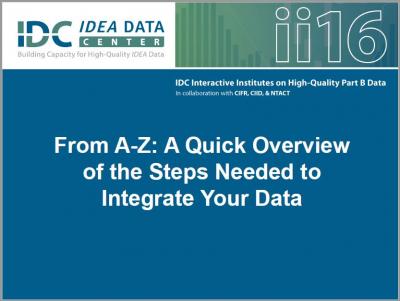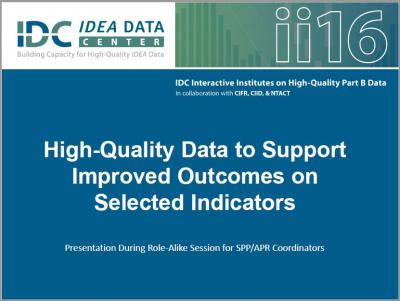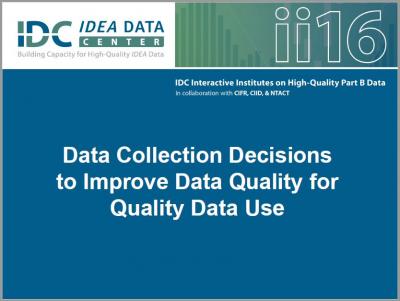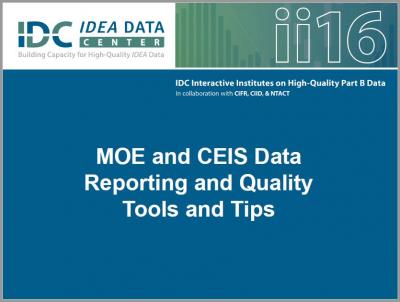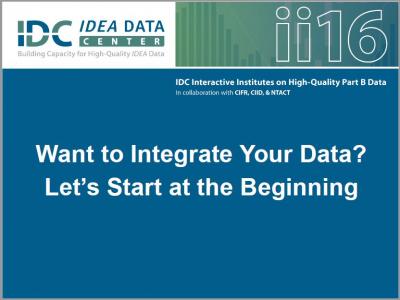Site Search
Results 15 - 21 of 26
Format: Presentations
From A-Z: A Quick Overview of the Steps Needed to Integrate Your DataAre you curious about what it might take to integrate your agency’s IDEA Part B data with other SEA data systems like a longitudinal data system? During this session, CIID staff provided a quick overview of the major steps required to integrate state-level data systems using the CIID Data Integration Toolkit.
Format: Presentations
High-Quality Data to Support Improved Outcomes on Selected IndicatorsThis interactive role-alike presentation for SPP/APR Coordinators engaged states in discussion and dialogue around their experiences with select APR Indicators that address student outcomes. The session included one state's experiences with capturing and using high-quality data and how the data are used to inform the APR and drive decisions for selecting and implementing strategies to improve student outcomes. Participants were encouraged to share their state's examples to improve the APR and student outcomes.
Format: Presentations
The Hard Work of Collecting Data on Quality and ComplianceThis session provided an overview of the landscape of Part B Indicator 13 data collection across the nation. Presenters shared insights from the TA Center charged with analyzing this indicator and two states that have wrestled with examining the quality of services in the compliance monitoring process. Presenters shared data, lessons learned, and suggestions.
Format: Presentations
Moving From Bystander to Participant: Engaging State Leaders During Data IntegrationCIID is facilitating a workgroup of SEAs interested in improving engagement of state leaders in IDEA data integration efforts. For data integration to succeed, SEAs and state leaders must communicate ideas, goals, and objectives clearly across departments and to various stakeholder groups. This role-alike presentation for state directors and leaders provided an opportunity for state leaders to learn how to move from being a bystander to an active participant in data integration efforts. Participants learned more about critical times for engagement, ensuring communication and cooperation among state leaders who rely on data for decision making, and positive outcomes that result from integrating IDEA data.
Format: Presentations
Data Collection Decisions to Improve Data Quality for Quality Data UseThis presentation provided an overview of the challenges of data collection for IDEA Part B Indicator 14 and identified some successful efforts to overcome challenges such as representativeness and response rates. Additionally, presenters shared one state's effort to improve the quality of their student post-school outcome data to increase confidence in programmatic decisions that could be made from those data.
Format: Presentations
MOE and CEIS Data Reporting and Quality Tools and TipsIDC and CIFR staff presented an overview of tools available to states and LEAs around LEA MOE and CEIS requirements and data quality. They also presented information on considerations states and LEAs need to keep in mind in relation to the MOE and CEIS requirements and data quality. One state presented information about the policies, procedures, practices, and tools/ templates it has in place to ensure LEAs meet the LEA MOE and CEIS requirements and improve data quality. The state staff also discussed their work with CIFR around the LEA MOE calculator.
Format: Presentations
Want to Integrate Your Data? Let’s Start at the BeginningStaff beginning a data integration effort within their state must first establish a clear purpose for integration. Focusing on the first step of integration during this session, CIID staff helped participants refine the purpose and use case for integrating their data. Also, participants used the CIID Data Integration Toolkit to develop a plan to ensure key stakeholder understanding of the purpose for, and improve their support of, data integration efforts in the state.

